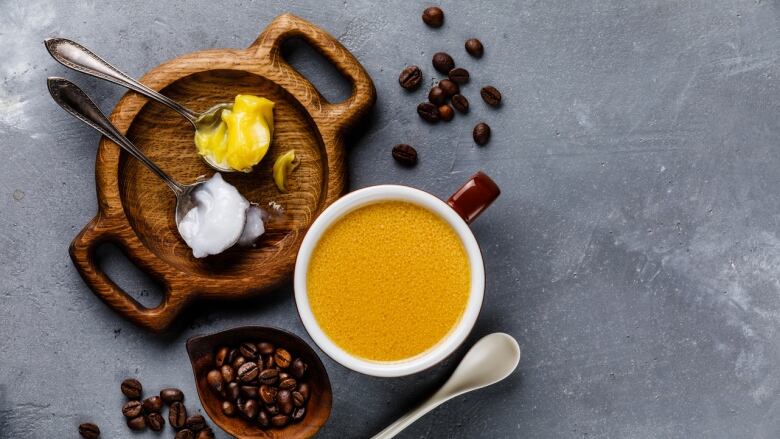Put what in my coffee? A roundup that might have you upgrading your morning cup Social Sharing
Reposted from the CBC
by RJ Skinner
Sure, you could go all out and whip up a Coffee Smoothie, a Coffee and Doughnut Milkshake or even DIY your own coffee cart, but there are easier ways to elevate your experience. Adding a unique ingredient to your coffee could be all it takes to seriously upgrade your cup.
Give your milk, cream and sugar a rest, and try popping one of these alternative additions into your morning brew.
Butter
If you haven't tried it yet, you've certainly heard of it — the butter coffee trend has grown steadily over the past decade, but its roots go back much further. Earliest practices can be traced back to Ethiopia, where roasted and ground beans were mixed with ghee (clarified butter) and then chewed for energy.
More recently, the butter coffee craze has been popularized by Bulletproof, a company that sells coffee along with nutritional supplements. Bulletproof claims that a breakfast consisting of coffee, grass-fed clarified butter and MCT (medium-chain triglycerides) is a health and performance booster (in conjunction with their recommended diet plan).
The general theory is that the high-fat mixture slows the metabolization of caffeine, and helps the consumer feel energized and satiated. That said, these health claims (along with the prescribed diet) have come under much scrutiny.
Curious about the flavour? Blending butter in your coffee creates a thick and full-bodied brew, similar in texture to a latte.
Cheese
If you're already loving butter coffee, it's a logical step to try a little more dairy in your cup. The Nordic treat of coffee with cheese, also popular in Russia, incorporates juustoleipä, which roughly translates to "cheese bread." Made from cow, goat or even reindeer milk, this cheese gets baked and dried, giving it a hard, toasted consistency.
Following tradition, you can either dunk the cheese in your coffee (like you would toast) or cube it, place it in your cup and pour your coffee over it, letting the cubes soak up the flavour. From there, the cheese can be spooned out and eaten or slurped up as a bottom-of-the-cup dessert.
Egg
You've already tried butter and cheese — might as well break a few eggs! But we're not suggesting you take your coffee over easy. Instead of cracking an egg into your cup, crack it into your coffee grounds, a practice that's believed to be a solution to poor-quality coffee in America developed by Scandinavian immigrants.
While recipes vary (some use just the egg, others include the shell), the usual technique is simple: mix the egg with the ground coffee; add the mixture to boiling water (it will eventually form a floating mass); remove the pot from the heat; add cold water; let it all sit for a few minutes (the mass will sink to the bottom of the pot like a French press plunger); and strain the liquid into a cup.
When heated, the proteins in egg whites break apart and bind to parts of the coffee grounds that may cause bitterness. In this way, the egg functions as a natural clarifying agent, says the Canadian Barista Institute (CBI), explaining why egg has also been historically used to make camping coffee when there are no paper filters handy.
Salt
If you're in a pinch — you've already poured your cup but find it's a little bitter — salt is your solution. The scientific explanation is that salt doesn't change the bitterness of coffee, but that sodium interferes with your ability to taste the bitterness, so you can better appreciate the other flavours in your drink.
This requires a bit of experimenting, since the amount of salt you use will depend on the bitterness of your coffee and the strength of your salt. (Be warned: using just a little more than the right amount could result in a disgusting brew of hot brown salt water!) You can also try adding the salt to your grounds before brewing. According to Alton Brown, you should try a quarter teaspoon of Kosher salt for every six tablespoons of coffee grounds to start.
Something else to keep in mind: the bitterness may not necessarily be caused by the coffee itself — it could be how you're brewing it. Using stale coffee or too-hot water, letting brewed coffee sit for too long, or using grounds that are too fine or coarse (or simply using too many) could all be culprits.
If you do have a tendency to botch the brew, take the advice of the CBI, which advises purchasing from a local and reputable roastery, making sure the beans are three to 14 days from their roasting date and grinding the beans immediately before brewing.
Tonic
Tonic water is a complex blend in it's own right, often a mixture of carbonated water, sugar and flavourings including quinine, which was originally used to treat malaria and gives the beverage a distinct bitterness that people either love or hate.
Figuring out the perfect combination of tonic water and coffee has become the latest trend in the coffee world. Many of today's baristas combine tonic with the much sweeter and less acidic cold brew coffee, creating something more akin to a refreshing, coffee-flavoured soda. With countless variations of both tonic and coffee on the market, there are plenty of creative combinations to be made.
What's next: Cannabis
Coffee and cannabis (the latter now legal across Canada) is a combination many people enjoy. Don't get too excited: Cannabis-infused edibles and beverages aren't legal yet (the Government of Canada projects they will be by October 2019).
That said, the federal government is already proposing new rules for the consumption of everything from cannabis-infused gummy bears and vegan sausage to tea, sodas and yes, coffee. Robert Carter, executive director of food services at research firm NPD Group, talked to CBC News about the potential of "cannabis cafes" in Canada. "I think there's something there from an emerging business model," he said.
One thing you may see pop up on your local cafe's menu is the trendy CBD latte. CBD, or cannabidiol, is a popular cannabis derivative that contains almost no THC (it won't get you "high"). But the research on its therapeutic effects isn't conclusive, so prepare to take any health claims with a grain of salt.
Consumers should also be aware of the health risks associated with cannabis, and that edibles affect the body differently than other forms of consumption, with effects lasting up to 12 hours. So if you're interested to try cannabis coffee this fall, now's the time to do your research.
What do you put in your coffee? Leave your tips in the comments while you're waiting for your beans to brew.



